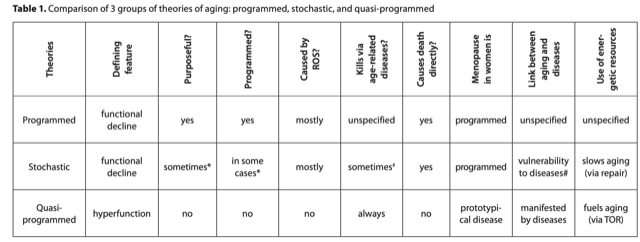What are the causes of ageing? Is it the accumulation of damage, or over-running healthy development? The latter is addressed on Aging is not programmed: Genetic pseudo-program is a shadow of developmental growth, and these are my notes on that paper.
Outline
Aging is not programmed is a short paper. In it Mikhail V. Blagosklonny looks at the nature of ageing as a “quasi-program” (also called “pseudo-program” and “hyperfunction”).
For comparison, a program is a system of changes that we need for development. It is selected for by evolution.
Ageing is not a program in this sense (and the first part of the paper argues why that is). Instead, ageing is the harmful, purposeless continuation of an actual developmental program that didn’t get switched off. It is program-like. It is a quasi-program.
Why this happens at all goes by the name of the “antagonistic pleiotropy hypothesis” (pleiotropy is a term for a single gene having multiple effects). Roughly, the hypothesis means that evolution will favour genes that increase fitness in early life, even if they turn out to be harmful in later life.
Aside: An example of a quasi-program
“…it was suggested that menopause in women is purposefully programmed to stop reproduction and to raise grandchildren instead”.
There are problems with that (common?) idea, including the assumption that group selection occurs. The alternative is that menopause is a quasi-program. The summary is that reproductive development is a chain of increasing resistance to estrogen, of which menopause is the end result. There are more details given in a separate paper, Why men age faster but reproduce longer than women (see references, below).
The cell cycle
At the cell-level, quasi-programs play out by continuing to stimulate growth.
The cell cycle describes the stages cells go through, resulting in cell division. There are various checkpoints in this process, and the cycle can be “arrested” (stopped).
“When the cell is stimulated to grow, while the cell cycle is arrested, then the cell becomes senescent (geroconversion)”
And what is triggering the arrest?
“[…] cellular senescence can be viewed as a continuation of differentiation [where cells become specialised]. The same cytokines [small proteins, involved in growth] that initially cause growth and proliferation then cause cell cycle arrest and differentiation.”
The normal genetic program for growth keep running and push cells into senescence. This leads to the diseases of ageing.
Features of quasi-program theory
Table 1 in the paper summarises differences between various theories of the mechanisms of ageing:

The defining feature of a quasi-program is the over-running we’ve discussed. This actively increases ageing.
This is contrasted with stochastic change where the main feature is a functional decline. Our bodies try to repair damage to slow ageing.
A positive outcome of quasi-program theory is:
" Since development and growth are relatively well understood, we can interpolate this knowledge to studying aging."
The paper highlights a particular pathway around mTOR (a pathway sensitive to nutrients) noting:
“Basically, genes that activate the mTOR pathway are gerogenes [genes that promote ageing], and those that antagonize the pathway are gerosuppressors [genes that supress ageing]”.
Summary
“I emphasize that the quasi-program does not exist for its own sake: it is a shadow. Aging has no purpose (neither for individuals nor for [the] group), no intention. Nature does not select for quasi-programs. It selects for robust developmental growth. Accelerated aging is the price for robustness.”
Programs are needed. It’s how we develop. We can’t stop that without adverse consequences. But there is a way this concept can lead to interventions:
“[…] pharmacologic interventions can be started in post-development, thus extending healthy lifespan.”
Resources
Mikhail V Blagosklonny (2013) Aging is not programmed:Genetic pseudo-program is a shadow of developmental growth. Cell Cycle 12:24, 3736–3742. DOI: 10.4161/cc.27188
Cell proliferation machinery, An Introduction to Genetic Analysis. 7th edition. A section from a textbook describing the cell cycle.
Ezcurra, Marina et al. C. elegans Eats Its Own Intestine to Make Yolk Leading to Multiple Senescent Pathologies.Current Biology, Volume 28, Issue 16, 2544 - 2556. DOI: 10.1016/j.cub.2018.06.035 An example of how the quasi-program theory in worms.
Blagosklonny M. V. (2010). Why men age faster but reproduce longer than women: mTOR and evolutionary perspectives. Aging, 2(5), 265–273. DOI: 10.18632/aging.100149.
Gems, D. and Partridge, L. (2013) Genetics of Longevity in Model Organisms: Debates and Paradigm Shifts. Annual Review of Physiology 75:621–44. DOI: 0.1146/annurev-physiol-030212-183712 A very readable discussion of the nature of ageing and quasi-programs.